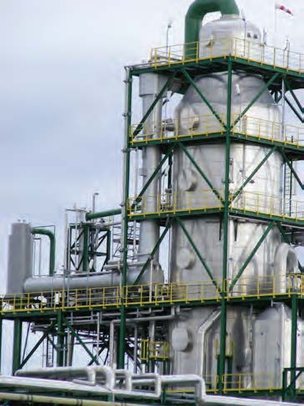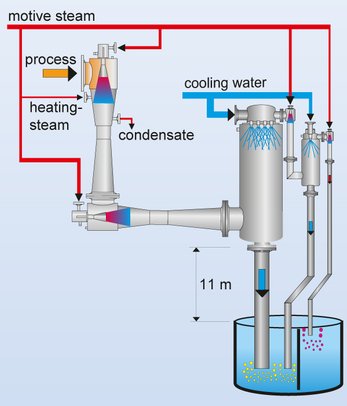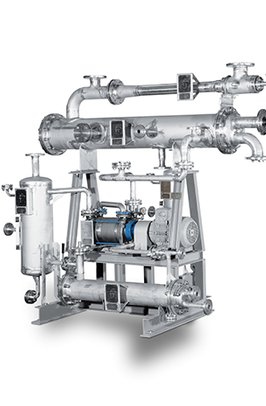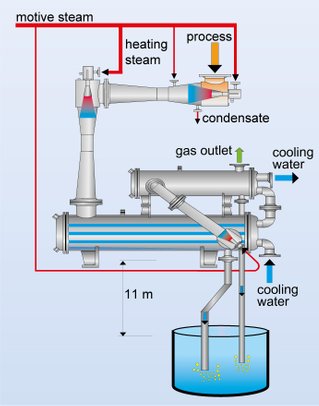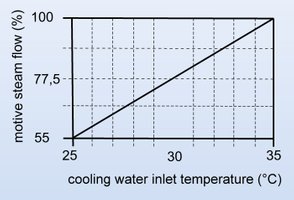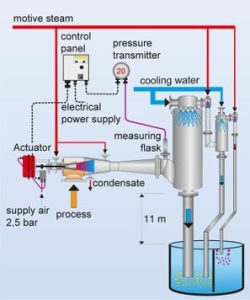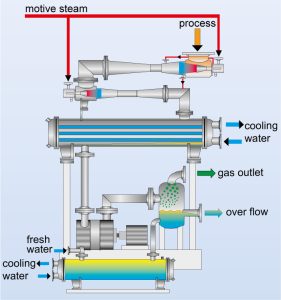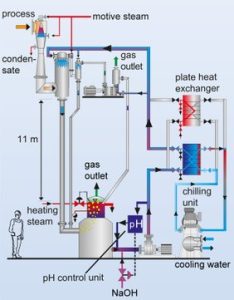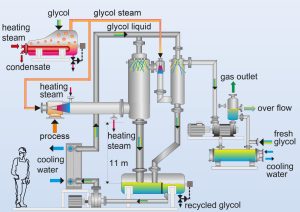Multistage Vacuum Systems
Vacuum components for industrial processes
For the generation of vacuum in industrial processes, Körting provides tailor-made solutions, Multistage Vacuum Systems, to meet the complex requirements in process engineering: suction pressure ranging down to 0.05 mbar absolute, suction flows down to 0.5 kg/h. The Körting technology including service and advice are essential components for high plant availability, reliabilty and safe operation.
Körting vacuum systems offer:
- low steam/energy consumption
- smart solutions for each application
- custom-made design
- plants that operate reliably
- first-class manufacturing quality
vacuum systems with mixing condensers
Körting multi-stage steam jet vacuum systems with mixing condensers offer a robust and maintenance-free operation.
Nearly unlimited applications as well as high operational reliability. The customised Körting vacuum systems with mixing condensers are approved and demanded solutions in the process industry. On the following pages you can find more information about the various application options.
The figure illustrated below achieves a suction pressure of 1 mbar. The temperature of the available cooling water determines which pressure can be reached in the first mixing condenser. In this example, two ejector stages are series-connected to achieve a suction pressure of 1 mbar with the lowest possible amount of motive flow. Two further ejector stages compress the non-condensable components of the suction flow of the first mixing condenser up to atmospheric pressure. The interconnected mixing condenser as well condenses the motive steam of the upstream ejector.
Advantages
- operation-free, robust operation
- approved operation for decades
- nearly unlimited application options
Disadvantages
mixing of process and cooling medium in the mixing condenser (can be equilibrated by means of vacuum system with surface condensers)
vacuum systems with surface condensers
Körting multi-stage steam jet vacuum systems with surface condensers keep the process medium and the cooling medium separate.
Customised Körting multi-stage vacuum systems offer a wide variety of applications. In the field of process engineering surface condensers have proven to be ideal. The decisive advantage is to separate the cooling and the process medium. There are different options of Körting vacuum systems with surface condensers available.
The figure below illustrates a 3-stage system. In this example two jet ejector stages are connected in series to achieve a suction pressure of 1 mbar with a minimum of motive medium. The temperature of the available cooling water determines the achievable pressure in the first surface condenser. A further jet ejector stage compresses the suction flow components of the first surface condenser which can’t be condensed to atmospheric pressure. The motive steam of the upstream jet ejector is condensed in the downstream surface condenser.
Advantages
- separation of process and cooling medium
- decades of experience, proven technology
- Körting places high demands on the quality of its own manufacturing at the Hanover location
Disadvantages
process and cooling water-sided pollution possible
Controllable vacuum systems
Steam jet vacuum systems can be equipped with a control unit to adapt to changing cooling water temperatures (summer/winter). So the minimum required motive steam consumption is automatically adjusted according to the respective cooling water temperature.
Controlling takes place within the motive flow zone through the reduction of the motive steam pressure or by varying the nozzle (nozzle needle) cross-section. Particularly, the nozzle needle control has shown good results as it utilizes the maximum expansion ratio throughout the motive steam nozzle. The nozzle needle can be axially displaced by means of electrical or pneumatic actuators.
As a result, this installation offers tailor-made consumptions and therefore reduced energy costs whereas performance remains unchanged. In contrast to non-controllable installations, the investment costs for controllable vacuum systems are higher. However, pay-back time is short.
Advantage
- decreasing of the motive steam amount and therefore reducing of the energy consumption
Vacuum systems with liquid ring vacuum pumps
Connecting ejectors with liquid ring vacuum pumps means combining the advantages of both systems. Liquid ring vacuum pumps are mechanical pumps with moveable parts. These parts are more prone to interferences than jet ejectors and investment costs are higher. However, operation is much more cost-effective.
These systems can be installed barometrically or non-barometrically. Jet ejectors and condensers can be mounted horizontally or vertically.
Advantages
- separation of process and cooling medium
- short start-up time even though no hogging ejector is used
- possibility of entraining condensate from the upstream condenser
Disadvantages
- process and cooling medium-sided pollution possible
- increased maintenance and repair costs (mechanical pump)
- exposed to potential damage through cavitation
- limited choice of materials
Alkaline Closed Loop - chilled water operated (ACL cold)
A chiller cools the cooling water down near to 0°C and then passes it to the mixing condensers. This means that condensation can take place at reduced pressure. Only one booster stage is required to effect compression up to the main condenser. Therefore, the amount of motive steam in the process is considerably reduced and operating costs are cut.
Polluted cooling water cycles around in a closed-loop system and is cooled down in the brine-cooled plate heat exchangers. Caustic soda is added to the circuit water to prevent contamination by fatty deposits in the plate heat exchangers. Condensate from the motive and suction steam is discharged together with impurities rising from the process via a special fat separator.
Advantages
- low energy requirements
- clean cooling water
- low maintenance costs
- minimum amount of waste water
Alternative system
Higher environmental demands and the need to reduce operating costs cause more and more plant operators to replace their conventional vacuum systems by ACL-Cold Vacuum Systems or ICE Condensation Vacuum Systems.
Process-vapour operated ejectors
If ejectors are applied for generating a vacuum, process vapour offers considerable advantages. The ejectors shown here are used to evacuate the polycondensation stage of a PET manufacturing process and generate a suction pressure of <1 mbar A. The whole vacuum system is operated as a closed-loop unit and uses ethylene glycol(EG,Glycol) as motive vapour, cooling and operating liquid.
These ejectors are double-jacketed and heated with HTM (oil) at 300°C. Mixing condensers are installed between the ejectors for condensation purposes. Polyethylene terephthalate (PET) is a thermoplastic of the polyester family, which is fabricated by means of polycondensation. Körting has been reliably fulfilling the high demands on these installations for decades and has successfully installed more than 200 Vacuum Systems of this kind World Wide.
Advantages
- environment-friendly (no cooling water and air pollution)
- energy-saving due to high efficiency
- environmental protection integrated into the process

